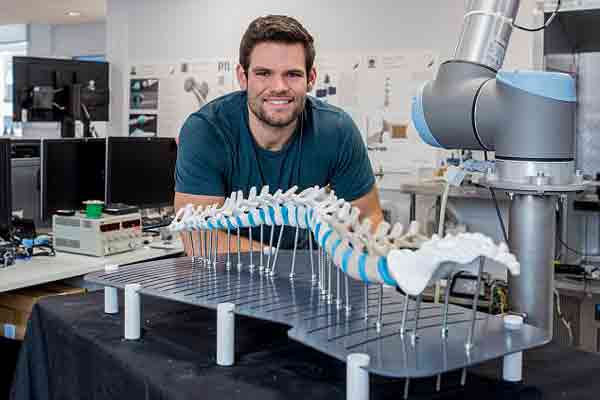

Lead researcher Joe Meeks (pictured) believes the 3D vertebrate will allow surgeons to practice life-saving spinal operations in a risk-free environment, boosting their confidence. Photo: Daily Mail
Nottingham, UK (BBN) - A human-like 3D vertebrate that allows surgeons to practice life-saving spinal operations could be available next year.
The model is intended to increase doctor's confidence at performing such procedures by allowing them to investigate patients' spines in a risk-free environment before undergoing the operation, according to the researchers, reports Daily Mail.
Patients should be assured their surgeon is aware of their specific ailment, with the model hopefully one day being able to be personalised to reflect people's specific condition, such as osteoporosis or sports injuries, they add.
Lead researcher Joe Meeks from Nottingham Trent University, told MailOnline: 'From a patient's perspective, a lot of mystery goes into surgery. They can be assured the surgeon knows what your spine looks and feels like. It gives the surgeon and patient confidence.
'Surgeons will be much more confident because they’ve practiced these procedures before in a nice, safe environment where there’s no life or death situation.'
WEIGHT-LOSS SURGERY COULD MAKE MEN INFERTILE
Weight-loss surgery could make men infertile, research suggested last month.
Semen abnormalities occur in 57.1 per cent of men after having bariatric surgery, a study by the Hospital das Clinicas in São Paulo found.
Only four per cent of the study's 79 participants fathered children after having the procedure, compared to 13 per cent before, the research adds.
Dr Edward Lin, editor-in-chief of the journal Bariatric Surgical Practice and Patient Care, which published the study, said: 'This study is one important piece in solving the puzzle of male infertility.
'The challenge is to see if correcting hormonal and micronutrient aberrations are enough to reverse male infertility.'
'IT GIVES THE SURGEON AND PATIENT CONFIDENCE'
Mr Meeks said: 'You can't learn spinal surgery through a textbook, much like you need to pick up a instrument in order to learn how to play it.
'Live surgery is an intense place with a lot of pressure.
'Models help surgeons understand the vertebrate so they are more clued up on what they're looking to feel.
'From a patient's perspective, a lot of mystery goes into surgery. They can be assured the surgeon knows what your spine looks and feels like. It gives the surgeon and patient confidence.
'Surgeons will be much more confident because they’ve practiced these procedures before in a nice, safe environment where there’s no life or death situation.'
PERSONALISED PER PATIENT
As the technology develops, the researchers are hopeful the model can be personalised per patient to reflect if they have, for instance, osteoporosis or sports injuries.
The model is made via 3D printing methods to recreate the look and feel of real bone, and has been approved by surgeons.
The inside of the vertebrate is a foam representing softer, inner bone, while the outer area is more resilient.
BBN/MMI/ANS